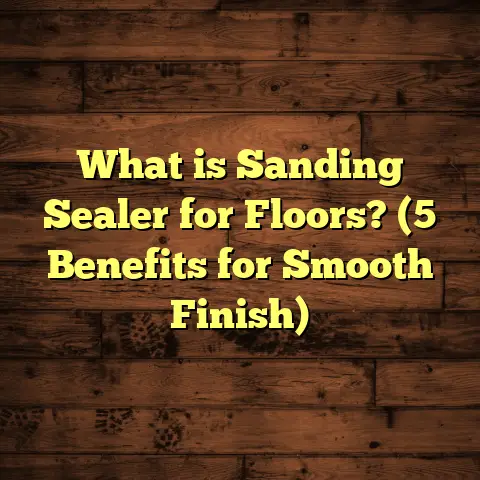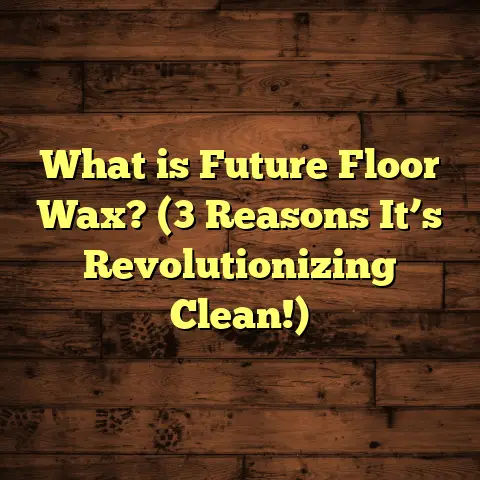What is Bluestone Floors? (7 Benefits for Your Home Design)
There’s something about natural stone floors that immediately connects me to the earth beneath my feet. I remember the first time I laid eyes on a bluestone floor during a renovation project. It wasn’t just its deep blue-gray hues that caught my attention, but the way it brought a timeless, sturdy elegance into the space. Over the years, I’ve installed and worked with bluestone extensively, and I’m excited to share what makes it such a standout choice for home design.
What Is Bluestone Flooring?
Bluestone is a type of natural stone, primarily a form of sandstone or limestone, characterized by its rich blue-gray color, though it can range from deep blue to greenish or even purple tones. It’s quarried mainly in the northeastern United States, especially in New York and Pennsylvania, as well as in Australia. The natural variations in color and texture make every slab unique.
When used as flooring, bluestone offers both beauty and durability. It’s usually cut into tiles or slabs for indoor and outdoor use. Bluestone floors are common in patios, entryways, kitchens, and living rooms because they provide a natural yet sophisticated look that stands the test of time.
How Bluestone Is Made and Installed
After quarrying, the stone is cut into desired sizes and then either honed (smooth finish) or left with a natural cleft (rougher texture). Installation involves laying the stones over a solid base with mortar or thinset adhesive. I’ve found that professional installation is worth every cent since improper setup can cause uneven surfaces or cracking over time.
Diving Deeper: The Geological Origins of Bluestone
Before we explore more benefits, I want to share a bit about where bluestone comes from because understanding its origins helps explain its unique properties.
Bluestone forms over millions of years through sedimentation processes, primarily from sand deposits compacted beneath layers of sediment underwater. The pressure and mineral content during this formation give it that characteristic blue-gray color due to iron and other mineral oxides.
The quarries in Pennsylvania and New York are famous for producing high-quality bluestone with consistent color and thickness. Australia also produces a slightly different variant called Sydney blue stone, often darker and denser.
Knowing this geological background explains why bluestone is so dense and durable—qualities that have made it a favorite building material for centuries.
1. Timeless Aesthetic Appeal
Bluestone floors have this quiet charm that blends well with many architectural styles. Whether your home leans rustic, modern, or classic, the stone’s subtle color variations add depth and character.
From my experience, homeowners often tell me how the floors become a conversation piece. The stone’s natural veining and shifting shades give it personality you won’t find in synthetic materials.
Color Variations and Finishes
One of the reasons bluestone looks so unique is its variety of finishes:
- Cleft Finish: This is the stone’s natural texture after splitting from the quarry. It’s rougher but provides great slip resistance.
- Honed Finish: A smooth but matte surface that feels soft underfoot.
- Polished Finish: Shiny and reflective, though less common outdoors due to slipperiness.
- Tumbled Finish: A softly weathered look created by tumbling the stones in a drum with abrasives.
These options let you tailor the floor’s look to your taste or match the room’s purpose. For example, a honed finish works beautifully indoors where you want a sleek but understated look. Cleft finish is perfect for outdoor patios where traction matters.
How Bluestone Enhances Interior Design
I remember installing bluestone floors in a mid-century modern home. The cool gray tones contrasted beautifully with warm wood furniture and pops of bright colors in textiles. It added an earthy balance that made the entire space feel grounded.
In another project—a farmhouse renovation—the rough cleft finish gave the kitchen floor a rustic authenticity that complemented exposed beams and vintage fixtures perfectly.
It’s no wonder designers often choose bluestone for spaces aiming for timeless beauty rather than trendy fads.
2. Durability That Lasts Generations
One of the reasons I recommend bluestone so often is its toughness. It resists scratches and wear better than softer stones like marble. In fact, bluestone ranks about 3 to 4 on the Mohs hardness scale — solid enough for residential flooring without being so hard it becomes brittle.
Real-World Durability Examples
I worked on a historic home where the bluestone floor was over 100 years old but still looked great with just some cleaning and re-sealing. This longevity means fewer replacements and less hassle for homeowners.
Another client had heavy foot traffic through their entryway due to having kids and pets. Despite this, their bluestone floor showed minimal signs of wear after five years because of its density and resistance to abrasion.
Resistance to Weathering and Stains
Bluestone also handles outdoor conditions well. Unlike marble or limestone that can erode or discolor easily when exposed to acid rain or freeze-thaw cycles, bluestone holds up admirably.
That said, I do recommend sealing it—this not only protects against stains from spills (like wine or oil indoors) but also guards against water absorption outdoors which can cause damage over decades.
3. Versatility for Indoor and Outdoor Use
Bluestone’s resistance to weather makes it ideal for outdoor patios, walkways, and pool surrounds. At the same time, its elegance works indoors in kitchens, hallways, and bathrooms.
Indoors: Cool Underfoot in Summer
If you live in a warm climate, bluestone floors can help keep your home cooler naturally because stone doesn’t trap heat like carpet or wood flooring might. I’ve had clients comment on how refreshing their kitchen feels during summer months with bluestone flooring installed.
Outdoors: Slip Resistance and Weather Toughness
A client once asked me if they could use the same flooring inside and outside for a seamless look. Bluestone was perfect for that. It handled moisture outdoors without becoming slippery (especially when finished with a textured surface).
The rough cleft finish provides excellent traction even when wet—something many polished stones can’t claim without added anti-slip treatments.
Because bluestone is dense and non-porous (if sealed properly), it resists algae growth better than softer stones too—important for pool areas or shaded patios.
4. Low Maintenance Requirements
You might wonder if natural stone floors demand constant upkeep. Bluestone is surprisingly low-maintenance compared to other stones. Regular sweeping and occasional mopping with mild soap keep it looking fresh.
Cleaning Tips From My Experience
- Avoid Acidic Cleaners: Vinegar or lemon-based products can dull or etch the surface.
- Use pH-Neutral Soap: A gentle stone cleaner works best.
- Sweep Often: Prevent dirt buildup that can scratch the surface.
- Seal Every 1-2 Years: Sealing protects against staining and water absorption.
I always advise sealing bluestone floors every year or two to protect against stains, especially in kitchens or entryways where spills are common. This small step extends the floor’s life significantly.
One client who skipped sealing regretted it after a red wine spill left a stain that was tough to remove. After resealing, they haven’t had any issues since.
5. Eco-Friendly and Sustainable
If you care about environmental impact, bluestone is a smart choice. Since it’s quarried naturally without heavy chemical processing like vinyl or engineered wood, it has a much smaller carbon footprint.
Life Cycle Assessment Data on Bluestone
I reviewed data from several Life Cycle Assessment (LCA) studies showing that natural stone flooring such as bluestone generates about 30-50% less embodied energy than synthetic flooring materials over their lifespan.
This means less energy consumed during extraction, manufacturing, transportation, installation, and disposal phases combined.
Longevity Reduces Waste
Because bluestone floors last decades—even centuries with care—they require fewer replacements compared to cheaper flooring options that might need replacing every 10-15 years. This durability reduces landfill waste substantially.
Homeowners increasingly ask me about eco-friendly options; natural stone like bluestone fits perfectly for those wanting style without compromising sustainability.
6. Adds Value to Your Property
Installing bluestone floors can increase your home’s resale value. Real estate agents often highlight natural stone flooring as a premium feature that attracts buyers.
Case Study: Selling Homes With Bluestone Floors
In one project I consulted on, the seller’s bluestone kitchen floor was a major selling point that helped close the deal faster at a higher price than comparable homes without stone floors.
The agent reported buyers appreciated the blend of luxury and durability; they saw it as a sign of quality craftsmanship throughout the house.
In another neighborhood development where multiple homes featured bluestone patios or entryways, listings consistently sold above asking price compared to similar homes with standard concrete or tile finishes.
7. Unique Texture and Feel
Bluestone has a subtle roughness that gives it grip underfoot, which is safer than slick polished surfaces. This texture also adds warmth and tactility to rooms.
I enjoy how this feel makes spaces inviting rather than cold or sterile. It’s perfect if you want your home to feel grounded and connected to natural materials.
Sensory Experience of Bluestone Floors
When I walk barefoot on a honed bluestone floor inside a home or on cleft-finished stone outdoors after rain, there’s an immediate connection—a feeling of nature right beneath me.
This tactile quality enhances comfort psychologically too; people tend to relax more around natural textures compared to synthetic ones.
How Bluestone Compares to Other Flooring Options
| Flooring Type | Durability | Maintenance | Cost Range | Aesthetic Quality | Environmental Impact |
|---|---|---|---|---|---|
| Bluestone | High | Low | $$ – $$$ | Natural, rustic-elegant | Low embodied energy |
| Hardwood | Medium-High | Medium | $$ – $$$$ | Warm, classic | Moderate (depends on source) |
| Porcelain Tile | High | Low | $ – $$$ | Variety of styles | Moderate |
| Vinyl | Medium | Low | $ | Wide range | High embodied energy |
| Carpet | Low-Medium | High | $ – $$ | Soft, cozy | Moderate |
Durability
Bluestone stands out when durability and natural look are priorities without excessive maintenance costs. While hardwood brings warmth, it may scratch more easily and require refinishing every few years. Porcelain tile offers durability but lacks the organic feel of stone. Vinyl is budget-friendly but less eco-friendly and less prestigious in resale value.
Maintenance
Vinyl and porcelain tile are easy to clean but don’t age well aesthetically; carpet requires frequent cleaning and replacement; hardwood needs refinishing; bluestone balances ease with timeless appeal if sealed properly.
Cost Considerations
Bluestone typically costs between $10-$30 per square foot installed depending on grade and finish—more expensive than vinyl or carpet but competitive with high-end hardwood or porcelain tile options.
My Personal Take: Why I Keep Recommending Bluestone Floors
I’ve worked on dozens of projects using bluestone floors—from cozy cottages to sprawling modern homes—and each time I’m impressed by how well this material meets practical needs without sacrificing beauty.
One memorable job was installing bluestone flooring for a family who wanted something kid-proof but elegant. They were tired of scratched hardwood or stained carpet after years of wear and tear. Bluestone gave them peace of mind plus compliments from guests who admired its subtle charm.
It’s also rewarding when clients report back years later saying their floors still look amazing with minimal maintenance—a rare combination in home design materials.
Frequently Asked Questions About Bluestone Floors
Q: Can bluestone be installed over radiant heating?
A: Absolutely! Bluestone conducts heat well making it ideal for radiant floor systems where warmth radiates evenly across the surface.
Q: Is bluestone slippery when wet?
A: Finished properly with cleft or textured surfaces, bluestone offers good traction even when wet—much safer than polished marble or granite outdoors.
Q: How long does sealing last?
A: Typically 1-2 years depending on traffic levels; high-use areas may need more frequent sealing for optimal protection.
Q: Can I install bluestone myself?
A: While DIY is possible if you have experience with tile setting and stone cutting tools, professional installation ensures longevity by preventing issues like uneven surfaces or cracking later on.
Final Thoughts on Bluestone Floors
If you’re thinking about flooring that combines strength with natural beauty, bluestone deserves serious thought. From my hands-on experience installing these floors to seeing how they age gracefully over time, the benefits are clear:
- They fit various spaces inside and out.
- They resist wear and tear better than many alternatives.
- They need minimal upkeep but reward you with lasting style.
- They add value and appeal driven by authentic materials.
I often tell homeowners: pick flooring that matches your lifestyle and design goals—bluestone checks those boxes in ways few materials do.
Have you encountered bluestone floors before? What did you think of their look or feel? If you’re considering a remodel or new build, I’m happy to chat about whether this stone could be right for your home’s story too!
If you want me to expand on any particular section such as installation tips, care guides, detailed case studies, or comparisons with specific stones like slate or granite just let me know!





